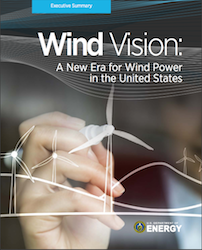The Wind Vision report released yesterday by the U.S. Department of Energy (DOE) is spurring reaction across the wind industry. The report describes a new scenario for wind to reach 10 percent by 2020, 20 percent by 2030, and 35 percent by 2050, and provides a road map for government and industry to get there. Wind industry executives are going on record saying they can and will deliver the goals set forth in the plan.
“We can do this and save you money by doing it,” said Tom Kiernan, CEO of the American Wind Energy Association (AWEA). “This definitive report provides the wind industry with aggressive targets for the growth of wind energy  in America, and we stand ready to meet them. It starts with getting common-sense policies in place, so we can double U.S. wind energy in the next five years.”
in America, and we stand ready to meet them. It starts with getting common-sense policies in place, so we can double U.S. wind energy in the next five years.”
In response to the report, AWEA along with the Wind Energy Foundation will set forth more than 50 industry executives and professionals to serve as ambassadors to educate Americans and elected officials about wind power benefits. In addition, over 400,000 supporters of wind energy have signed a petition calling on state and federal lawmakers to support the needed policies.
“This report documents how wind energy already provides major economic and environmental benefits to America, including protecting consumers against energy price spikes, and making deep cuts in pollution and water use,” added John Kostyack, executive director of the Wind Energy Foundation. “As wind becomes one of the country’s top sources of electricity, Wind Vision promises even bigger benefits for decades to come.”
Wind Vision envisions how consumers will immediately benefit from more stably priced energy. With more wind energy, electricity prices would be 20 percent less sensitive to fluctuations in the price of fossil fuels, the report finds. Consumers would see $280 billion in economy-wide savings from reduced natural gas prices alone. Investing in more U.S. wind turbines would pay further economic dividends, such as by creating more jobs and causing further reductions in air pollution. The up-front investment to achieve these benefits will cost electric consumers only pennies a month in the early years, the report shows.
The reports states consumers will see direct savings as wind technology continues to improve and fossil fuel energy sources become more expensive, with annual consumer savings reaching $14 billion a year by 2050, and cumulative savings on U.S. electric bills amounting to $149 billion by then. If fossil fuel prices increase more than expected, electric consumers would start to see direct savings even sooner.
“As the report notes, adding high capacity transmission infrastructure is critical to achieving that vision,” said Michael  Skelly, president of Clean Line Energy Partners. “America is blessed with vast renewable resources, but much of it is off limits because of a severe lack of transmission capacity.” Clean Line is working to develop what would be the first new interstate HVDC lines in three decades – projects that would facilitate tens of billions of dollars in wind development.
Skelly, president of Clean Line Energy Partners. “America is blessed with vast renewable resources, but much of it is off limits because of a severe lack of transmission capacity.” Clean Line is working to develop what would be the first new interstate HVDC lines in three decades – projects that would facilitate tens of billions of dollars in wind development.
Wind Vision anticipates that the cost of land-based wind energy can still be further reduced 33 percent by 2030. The report finds the industry has already exceeded the cost reductions and growth trajectory outlined in the 2008 report, because of technological improvements and smart, performance-based policies. Through 2013, the U.S. wind industry exceeded that report’s aggressive cost reduction projections by 32 percent and its wind deployment projections by 27 percent.
However Skelly cautions that without interstate HVDC transmission projects, the “vision” will not become reality. The last HDVC transmission project in the U.S. occurred in 1986. “This has to change. Ultimately, this is about America’s competitiveness – ensuring that residents, businesses and manufacturers in every region of the country have access to safe, secure, affordable wind energy,” concluded Skelly.

